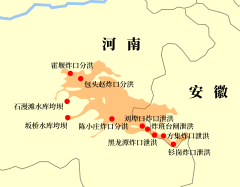
Back Colapso de la presa Banqiao Spanish Effondrement du barrage de Banqiao French Kebobolan Bendungan Banqiao 1975 ID 1975-ലെ ബാൻചിവിയാവ് അണക്കെട്ട് തകർച്ച Malayalam Przerwanie zapory Banqiao w 1975 Polish Прорыв плотины Баньцяо Russian 1975 Banqiao Baraj Faciası Turkish Прорив греблі Банцяо Ukrainian 河南“75·8”水库溃坝 Chinese
 Flooded area of 1975 Banqiao Dam failure | |
| Date | August 8–9, 1975 |
|---|---|
| Location | Henan, China |
| Cause | Typhoon Nina, engineering flaws, failures in policy |
| Deaths | 26,000–240,000 |
| Property damage |
|
| 1975 Banqiao Dam failure | |||||||
|---|---|---|---|---|---|---|---|
| Traditional Chinese | 河南「75·8」水庫潰壩 | ||||||
| Simplified Chinese | 河南"75·8"水库溃坝 | ||||||
| |||||||
In August 1975, the Banqiao Dam and 61 others throughout Henan, China collapsed following the landfall of Typhoon Nina.[1][2][3][4] The dam collapse created the third-deadliest flood in history which affected 12,000 km2 (3 million acres) with a total population of 10.15 million, including around 30 cities and counties, with estimates of the death toll ranging from 26,000 to 240,000.[1][3][4][5][6] The flood also caused the collapse of 5 million to 6.8 million houses.[5][7] The dam failure took place in the context of the Cultural Revolution.[4]
Many of the dams that collapsed were originally constructed with the help of Soviet advisors. Many were built during the Great Leap Forward.[2][5][8][9][10] The construction of the dams focused heavily on the goal of retaining water and overlooked their capacities to prevent floods, while the quality of the dams was also compromised due to the Great Leap Forward.[2][5][8][9] The Banqiao dam had been designed for a calculated one in a thousand year rainfall event of 300 mm per day; however, more than the normal yearly rainfall (1,060 mm) fell in just one day near the typhoon center.[11][12] Some experts have also stated that the focus on peasant steel production during the Great Leap Forward, as well as a number of policies from the campaign to "Learn from Dazhai in agriculture", severely damaged the ecosystem and forest cover in the region, which was a major cause of the flood, and the government's mishandling of the dam failure contributed to its severity.[5][8]
In the aftermath, various elements of the Chinese government concealed the details of the disaster until the 1990s, when the book The Great Floods in China's History (中国历史大洪水), prefaced by former Minister of Water Resources Qian Zhengying, revealed details of the disaster to the public for the first time.[5][8][9][12][13] The official documents of the disaster were declassified in 2005 by the Chinese government.[9][12][14]
- ^ a b Xu, Yao; Zhang, Li Min; Jia, Jinsheng (2008). "Lessons from catastrophic dam failures in August 1975 in Zhumadian, China". Hong Kong University of Science and Technology. American Society of Civil Engineers. Archived from the original on 2020-03-25. Retrieved 2020-03-25.
The breaching of these dams caused an inundated area of 12,000 km2, a death toll of over 26,000, and economic loss of more than RMB10 billion.
- ^ a b c Fish, Eric (2013-02-08). "The Forgotten Legacy of the Banqiao Dam Collapse". The Economic Observer. Archived from the original on 2021-05-06. Retrieved 2020-03-25.
- ^ a b "Dam Failure and Flood Event Case History Compilation" (PDF). United States Bureau of Reclamation. June 2015. pp. 114–119. Archived (PDF) from the original on 2016-09-29.
- ^ a b c "1975年那个黑色八月(上)" [The Dark August of 1975 (1)]. People's Daily Online (in Chinese). China Energy News. 2012-08-20. Archived from the original on 2020-05-06. Retrieved 2020-03-25.
长期以来,官方公布的数据一直备受质疑。譬如美国Discovery频道制作的"10 top technological catastrophe in the world"(世界十大科技灾难)专题片即认为:溃坝造成的直接死亡,加上后续因缺粮、感染、传染引起的死亡,人数共计24万多人。无论是2.6万,还是3.2万,或者是24万,事实上,官方从来也都没有过准确的伤亡数据。...... 8月20日,省委有个初步统计数字,说全省死亡85600多人,连同外地在灾区死亡的人数在内,最多不超过10万人。当时省委说,这个数字比较准确。所以中央慰问团在给毛主席、党中央写的关于河南、安徽灾情报告中,用了这个数字。
- ^ a b c d e f "75年河南水灾:滔天人祸令十万人葬身鱼腹" [The 1975 Henan Flood: one-hundred thousand people died in a heinous man-made disaster]. Phoenix New Media (in Chinese). 2008-08-10. Archived from the original on 2021-01-07. Retrieved 2020-03-25.
- ^ "The Catastrophic Dam Failures in China in August 1975". San Jose State University. Archived from the original on 2002-04-26. Retrieved 2020-03-25.
- ^ Jiang, Hua; Yu, Chen. "驻马店地区:水墓:河南"75.8"特大洪水35周年祭". Chinese University of Hong Kong. Southern Metropolis Daily. Archived from the original on 2020-03-30. Retrieved 2021-07-23.
- ^ a b c d "1975年那个黑色八月(下)" [The Dark August of 1975 (2)]. People's Daily Online (in Chinese). China Energy News. 2012-08-27. Archived from the original on 2020-05-06. Retrieved 2020-03-25.
- ^ a b c d "230,000 Died in a Dam Collapse That China Kept Secret for Years". OZY. 2019-02-17. Archived from the original on 2020-03-25. Retrieved 2020-03-25.
- ^ IChemE (8 August 2019). "Reflections on Banqiao". Institution of Chemical Engineers. Archived from the original on 2019-08-08. Retrieved 2020-03-25.
- ^ Burt, Christopher C. (May 30, 2018). "The Deadliest Weather-Related Catastrophe You Probably Never Heard Of". Weather Underground. Archived from the original on 2022-01-12. Retrieved 2022-01-15.
- ^ a b c Cite error: The named reference
After30Yearswas invoked but never defined (see the help page). - ^ "The Three Gorges Dam in China: Forced Resettlement, Suppression of Dissent and Labor Rights Concerns". Human Rights Watch. February 1995. Archived from the original on 2009-02-05. Retrieved 2020-03-25.
- ^ Cite error: The named reference
:9was invoked but never defined (see the help page).